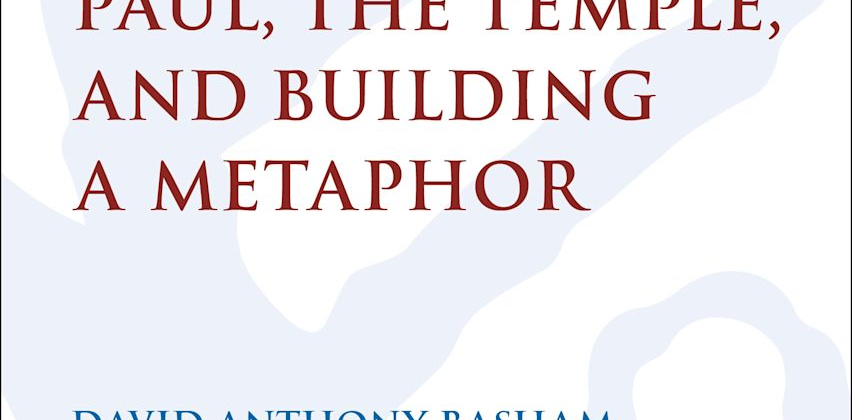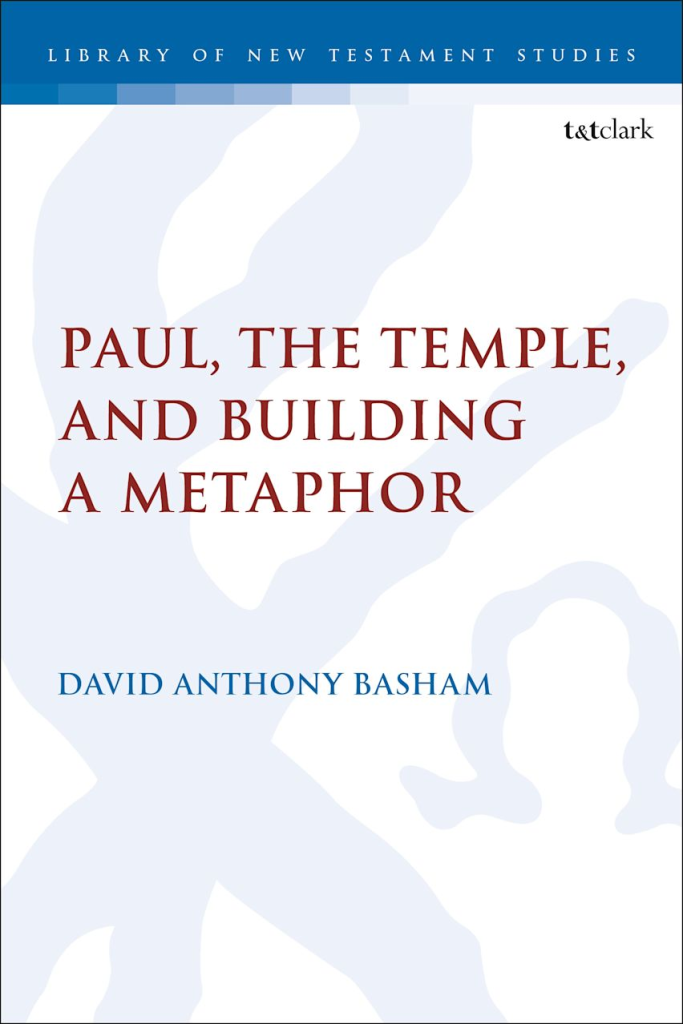

David Anthony Basham is Assistant Professor of New Testament at Ashland Theological Seminary, and today is publication day for his first book, Paul, the Temple, and Building a Metaphor (T&T Clark). In the interview below, he answers a few questions about this project and its significance.
***
Congratulations on your book! I would love to hear a bit of the back story about this project: How did you arrive at this project? What is your main argument here, and why does it matter?
Thanks for the opportunity to share! Honestly, I was afraid to pursue something on Paul for the longest time. I entered graduate school more interested in the Gospels, especially Mark, and Acts. I knew that, due to the breadth and depth of Paul’s writings, the world of Pauline studies would require a lot of orientation. And it’s a world fraught with controversy on a plethora of topics. Like Jesus, everyone has their “Paul.”
I think I was baited into writing on Paul in two ways. First, I was increasingly interested in the role of the Jerusalem temple in the first century AD, both while it stood and in how the memory of it was used by Jews and Christians alike post-destruction (AD 70). Second, I began to notice how often “cultic” language is employed across the New Testament, especially in Paul, to explain life in Christ. Paul tells the Roman church that he is ministering his gospel like a priest and that the nations are his offering, which he hopes will be well-pleasing to God (Rom 15:16). In Phil 2:17, he tells the Philippians that he is being poured out as a drink offering on their behalf. Paul’s language in these instances is “cultic” since he refers to actual rituals of veneration. Yet, they are also instances of metaphor since, in the words of Janet Soskice, they “speak about one thing in terms which are seen to be suggestive of another.” Such rituals provide Paul with the only adequate language to express the significance of his work and possible death. As Sallie McFague puts it, metaphor is a strategy of desperation, not decoration.
This led me to 1 Cor 3:16–17: “Do you not know that you all are God’s temple and that the Spirit of God dwells among you? If anyone corrupts God’s temple, God will destroy this one; for God’s temple is holy, which is what you all are.” In what ways was the Corinthian church “God’s temple”, and how might such a pronouncement affect the Jerusalem temple? That led me down the rabbit hole of “metaphorology”—what metaphors are and what they do, especially in ritual settings. It also thrust me headlong into the question of Paul and Judaism, which I’m sure is a topic for another time!
In short, I was uncomfortable with the ways scholars seemed to protect the Jerusalem temple from Paul’s judgment, even though they could concede that he took hardline positions on gentiles and circumcision, food laws, holy days. I conclude that Paul’s application of temple language to gentiles-in-Christ like the Corinthians is ritually consequential, indicating that the Jerusalem temple is no longer needed because of the Spirit’s presence among them. This may seem like a no-brainer to some today, but it can’t be understated historically how consequential this language is while the temple still stood and because gentile pilgrims frequented the Jerusalem temple.
On the one hand, this is an academic book, but you have noted before that your argument has significance beyond just the academic world. What are a couple of takeaways from your research here for pastors and/or for regular churchgoers?
I recently advised an undergraduate thesis on this topic. I gave him a copy of my book because he was concerned to see churches more gripped by the idea of being God’s temple. While this project is historical in nature as I try to say something about earliest Christianity, I hope to pursue implications for the church in another publication with less scholarly jargon. Again, the impact of Paul’s language cannot be understated. Paul calls the Corinthians (the most troublesome of his churches!) naos theou in Greek, “God’s temple”. The word naos often indicates the Holy of Holies where God is uniquely present. The uncircumcised brought near by faith, though historically excluded from Israel, are referred to as that most intimate place where God meets with his people. They are holy and included because of Christ.
Can you give us a taste of something unexpected that you found in your work on this book or the original dissertation?
My consumption of coffee reached new and staggering heights! I finished my dissertation (on which this book is based) during a research fellowship I received from the University of Groningen’s Qumran Institute in the Netherlands (because I compare Paul’s temple imagery to similar language in the Dead Sea Scrolls). For so many reasons, it was the perfect setting to finish writing. One of which was the amount of coffee I had access to! Because I was also working for the university, I could get free coffee from these machines all over campus. All you had to do was swipe your ID card and out popped a cappuccino! I learned that the Dutch are among the topic consumers of coffee in the world when it comes to cups per person, so I fit right in.
What are the broader questions that fascinate you in your reading, thinking, and writing?
I am fascinated by development and evolution in religious thought and practice. Again, that’s partly what led me to the topic of this book. Metaphor is often the vehicle for such change. For example, one can imagine that the Old Testament image of a circumcised heart was necessary to combat a purely external understanding of circumcision without the necessary change in disposition toward God and neighbor. This represents the strategy of desperation mentioned above. You can feel the biblical writers reaching for language that somehow gets at a religious reality. Then you come to Romans 2 where Paul will use that same image of a circumcised heart to argue that real circumcision is only of the heart and that this negates the need for gentiles to be circumcised. Whether in biblical history or church history, I’m interested in the ways in which ideas like these reverberate through history when new obstacles and needs arise.
It always seems overly aggressive to ask someone who just published a book: what’s next? But I know that you are, in fact, already working on your next book, so I’m asking in my most encouraging and friendly tone here: what’s next for you?
It is funny. There’s always the next thing. In seminary, all I could think about were PhD programs, then finishing the PhD, then getting the dissertation published. I was so elated when I received word that T&T Clark had accepted it; but after a few days I was already thinking about the next thing! I have several articles in the pipeline. I just signed a contract with Fortress Press to start on a project addressing the use of conscience in the New Testament and Apostolic Fathers, though primarily focused on the Pastoral Epistles. It builds on my MA thesis at Durham University in England many moons ago.
As I said above, I knew I’d be devoting years of my life to Paul, which is certainly not a bad thing! But I’m also trying to venture elsewhere. I’ll be contributing to a Society of Biblical Literature volume entitled John, Jesus, and History. I’m really excited by Paul Anderson’s work on taking John’s Gospel more seriously as a historical source. At the end of the day, I hope that the things I produce are faithful and beneficial beyond the academy.